Follow Marina Spironetti as she unveils the treasures of the cobbled city of Mantua, one of the most atmospheric places to visit in northern Italy…
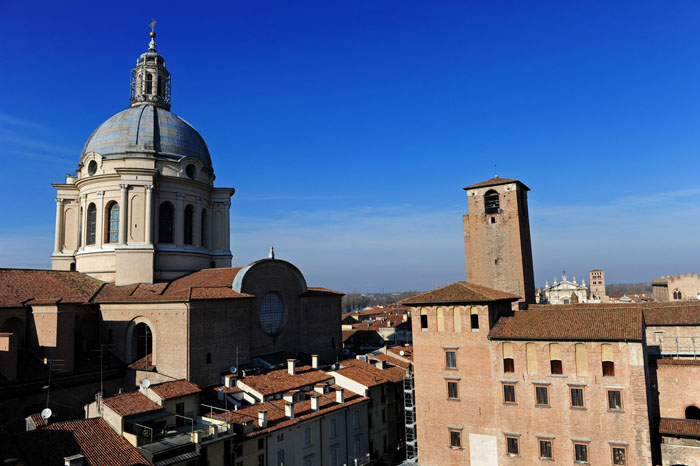
A year ago yet another earthquake shook most of northern Italy, causing considerable damage. When I went back to Mantua a couple of months ago, I did not know what to expect.
I knew some of the sights were closed to the public and the city was still struggling with the consequences. Apart from some scaffolding in the centre, though, I was relieved. In the 15th century, writer Baldesar Castiglione defined Mantua as “a city in the form of a palace” and I was pleased to note that the definition was still valid. Even after the earthquake, Mantua has that feeling of untouched beauty.
The centro storico is a pleasure to ramble around. Its narrow cobbled streets abound with antique shops, atmospheric cafés and delis – and every now and then they open up into one of those harmonious piazzas the city is famous for. If you are familiar with other northern Italian cities, Mantua will strike you for being a mixture between Bologna and Venice. Spiritually – and, by coincidence, geographically also. It has the same elegant arcades and the joyful comings and goings of bicycles as Bologna. With Venice, on the other hand, the connection is on a deeper level: water. Just like La Serenissima, water seems to be the lifeblood of the city. Approaching the city from the San Giorgio bridge, its medieval skyline of towers and domes appears almost completely surrounded by it. The river Mincio has swollen out into three lakes, which turn the city almost into an island. In addition to that, the city is divided into two by a rio, a medieval canal.
The bond with water also constantly changes the ambience of Mantua: humid and sticky in the summer, when its western lake turns violet and pink with delicate lotus blossoms; moody and misty in the winter months. The fog, which is regarded by many as a curse, only adds to its charm. In its vapours, the city is still the sombre background of Verdi’s Rigoletto and the setting of Romeo’s exile.
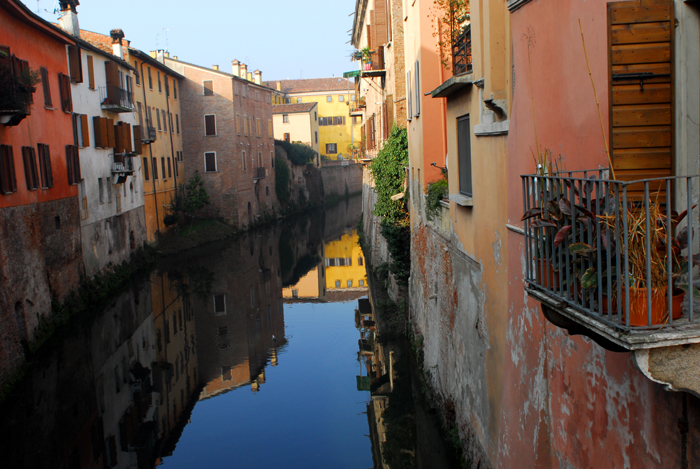
SPRINGING INTO LIFE
In ancient times, being the birthplace of Roman poet Virgilio was Mantua’s only trait of distinction. Not much else was heard from it until the 14th century, when it became the playground of the Gonzaga family. They were to Mantua what the Medicis were to Florence. Under their rule, Mantua flourished into one of the most renewed and admired cities in Europe. Needless to say, artists of the highest calibre flocked there: Pisanello, Leon Battista Alberti, Giulio Romano and Andrea Mantegna, as well as musicians like Claudio Monteverdi.
Any tour of the city should start from the delightful Piazza delle Erbe, bordered by the rear façade of Palazzo Broletto, the Casa di Boniforte da Concorezzo with its elegant stuccoes, and the evocatively-named Palazzo della Ragione (Palace of Reason), with a stout tower featuring an astronomical clock. The tower is currently closed because of the earthquake – and I do hope it will reopen to the public, as from its top you can enjoy one of the most beautiful aerial views of the city.
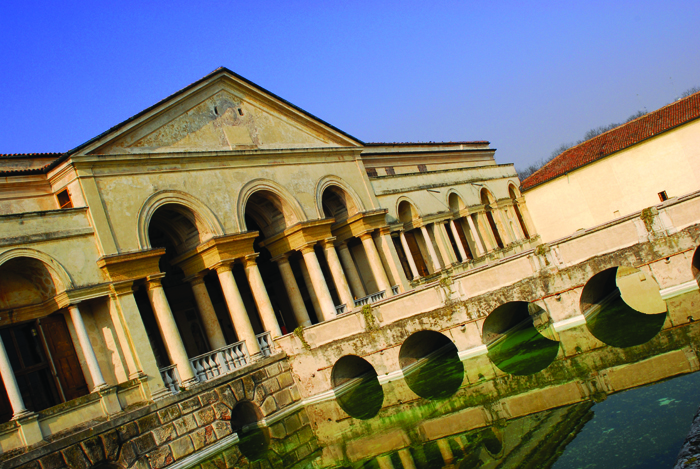
Sunk below the level of the modern pavement is the 11th-century Rotonda di San Lorenzo, modelled on the church of the Holy Sepulchre in Jerusalem. From there, the grand cobbled Piazza Sordello is only a stone’s throw away. On one side rises the sombre Bonacolsi palace with its Torre della Gabbia, thus named because of the iron cage that was kept to suspend the prisoners over the city back in the Dark Ages. When the Bonacolsi were overthrown by the Gonzagas in the military coup of 1328, the latter built their own Palazzo Ducale, just opposite the one of their predecessors. The Gonzaga’s personal Versailles was created in times when modest understatement was yet to be discovered: 500 rooms connected by a labyrinth of corridors, ramps, staircases and courtyards over a total floor space of 35,000m².
After the 2012 earthquake the palace temporarily closed to the public and has only recently reopened its doors. Some parts are sadly still not accessible, including Mantegna’s Camera degli Sposi, which captures the life of Ludovico Gonzaga and wife Barbara almost like a modern family album.
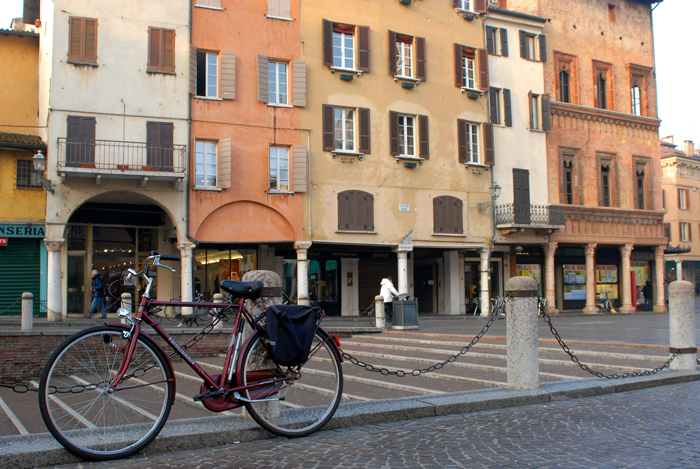
THE CHAMBER OF GIANTS
A pleasant 20-minute stroll to the other side of the city will take you to the equally impressive Palazzo Te, Giulio Romano’s masterpiece (www.palazzote.it, €8). Its name does not derive from tea – te in Italian – but from the less evocative word tejeto, a dialect term to describe a drainage canal. The palace stands indeed on a former swamp, quickly drained in order to build a love nest for Federico II and his mistress Isabella Boschetti. The interior is spectacular, featuring room after room of erotic frescoes. The most famous, the head-spinning Chamber of the Giants, depicts the mythical battle between the giants and the Greek gods. The scary effects of the vast murals spreading from the walls all over the ceilings is augmented by the tremendous acoustic effect: drop a button on the floor in here and the noise will be heard five rooms away. Rumour has it that Federico and his lover were particularly fond of making love there, which must have made quite a commotion.
A trip to the nearby walled town of Sabbioneta should also be part of your stay. An hour’s drive southwest of Mantua, it was built as a sort of ideal dream city by Vespasiano Gonzaga, prince of Bossolo and member of a cadet branch of the Gonzaga family. Particulary worth seeing are the Palazzo Ducale with its wooden equestrian statues of Vespasiano and his kin, and the small 16th-century Teatro Olimpico, the second-oldest surviving indoor theatre in the world after the one in Vicenza, which served as its model.
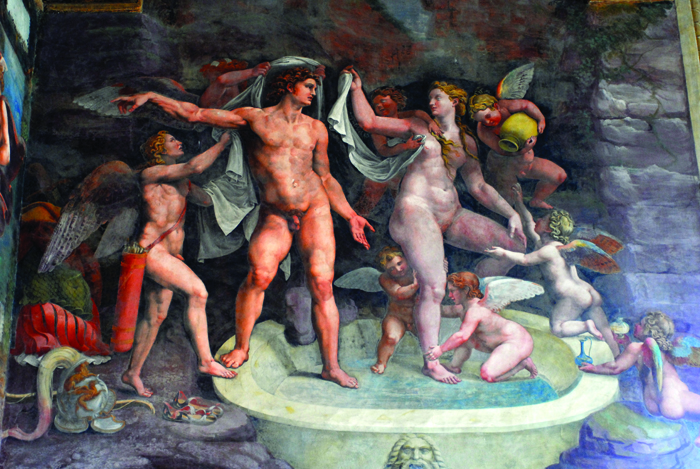
GLORIOUS FOOD
Art-loving Gonzagas are also responsible for the city’s peculiar cuisine. Compared to other regions of Italy, people tend to eat some quite unusual things here. Deep-fried frog legs, for example. Rabbit ragù. Or even the less-than-appealing marinated raw eel. Or the notorious stracotto d’asino – stew made from the flesh of a donkey.
It all sounds like a world apart.
Apart from donkey casserole, Mantua is a foodie paradise and has a lot to offer even if you don’t have a
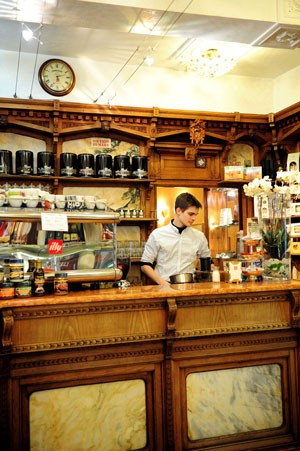
very adventurous taste. If you like pumpkin, for example, you are in the right place: sweet tortelli di zucca (large ravioli stuffed with pumpkin and almond) are ubiquitous, and so is risotto, due to the proximity of abundant rice fields. The most typical is the risotto alla pilota, served with salamella sausage. Beef stew can be a safer alternative to the donkey version if you’re not feeling intrepid – try it with zesty mostarda di Mantova, a local condiment made from candied sour green apples.
Those with a sweet tooth will not be disappointed either. The most famous dessert is the torta Sbrisolona, a mouth-watering almond and sugar-based hard
cake. Its name literally means “crumbly cake” due to the fact that you cannot cut it into slices
but you have to break it in pieces. It is delicious for breakfast, dipped in a caffe latte, or after lunch, accompanied by a glass of dessert wine such as vin santo.
Click here for top tips for a holiday in Mantua!
Photography © Marina Spironetti
